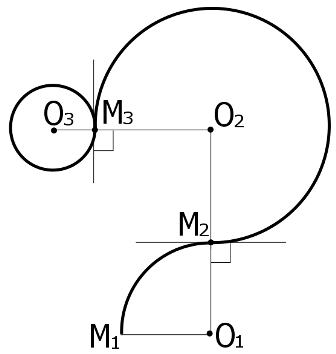| ENG RUS | Timus Online Judge |
NEERC 2014, Четвертьфинал Восточного подрегиона
Соревнование завершено
E. Магия и наукаОграничение времени: 1.0 секунды Ограничение памяти: 64 МБ Учёные, специализирующиеся в области колдовских наук, недавно открыли
новую элементарную частицу — магион.
Изучая законы, которым подчиняется движение магионов, группа из трёх
учёных-магов проводит следующий эксперимент. Ученые создали в лаборатории однородную положительную ауру.
Сила взаимодействия с этой аурой имеет постоянную величину и направлена вертикально вверх.
Если бы на магион не действовала никакая другая сила, то под действием ауры он бы двигался с постоянным ускорением (0,0,a). В точку M1 = (0,0,0) помещается магион, скорость которого равна нулю.
В начальный момент времени первый учёный создаёт в точке O1 сгусток маны.
Магион тут же попадает под действие этого сгустка и, пока тот существует, находится на расстоянии O1M1 от точки O1.
В результате магион начинает движение вверх по дуге окружности omega1 с центром в O1. В некоторый момент времени первый учёный испаряет сгусток маны в O1, а
второй учёный одновременно создаёт свой сгусток в точке O2.
Момент для этого выбирается следующим образом.
Расположение точки O2 выбирается так, чтобы точка M2 была однозначно
определена и не совпадала с точкой M1. Магион, попав под действие
второго сгустка, продолжает своё движение по окружности omega2 с центром в
точке O2, проходящей через точку M2.  После чего процедура повторяется — второй учёный испаряет свой сгусток
маны, а третий учёный создаёт свой в точке O3. Магион, находящийся
в этот момент времени в точке M3, теперь начинает двигаться по
окружности omega3 с центром в O3. Третий учёный ждёт, пока
магион не опишет полный круг по окружности omega3 и не вернётся в точку
M3. Этот момент считается моментом завершения эксперимента. Все учёные выбирают моменты и места создания сгустков маны
так, чтобы точка Mi не совпадала с точками Mi−1 и Oi,
а расстояние от Oi до любой точки окружности omegai−1, отличной от
точки Mi, было строго больше OiMi.
Кроме того, учёные следят, чтобы в каждый момент времени, кроме
начального, скорость магиона не была равна нулю. В любой момент времени на магион действуют ровно две силы: сила
взаимодействия со сгустком маны и сила взаимодействия с аурой.
Первая из них всегда направлена перпендикулярно траектории движения магиона и
поэтому не влияет на модуль его скорости. Сможете ли вы, зная координаты точек Oi и величину ускорения a,
определить суммарную длину участков траектории магиона, на которых его скорость была не менее v? Исходные данныеВ первой строке записано целое число t — количество экпериментов,
проведённых учёными (1 ≤ t ≤ 1000).
Далее дано описание экспериментов, каждый эксперимент описывается блоком из
четырёх строк. В первой строке блока записаны целые числа v и a
(1 ≤ v ≤ 50 000; 1 ≤ a ≤ 1000).
В каждой из следующих трёх строк блока записаны
целые числа xi, yi, zi — координаты точки Oi
(−106 ≤ xi, yi, zi ≤ 106; x12 + y12 > 0).
Гарантируется, что в траектории магиона не будет горизонтальной
дуги, по которой он будет перемещаться со скоростью v. РезультатДля каждого проведённого эксперимента в отдельной строке выведите суммарную длину участков
траектории магиона, на которых его скорость была не менее v.
Ответы должны иметь абсолютную или относительную погрешность не более 10−6. Пример
ЗамечанияВ данном примере был проведён один эксперимент. Траектория имеет следующий вид: от точки (0,0,0) до точки (4,0,2) — дуга меры arcsin(0.8) окружности с радиусом 5; от точки (4,0,2) до точки (20,16,2) — четверть окружности с радиусом 16; от точки (20,16,2) до точки (20,16,2) — полная окружность с радиусом 1. Автор задачи: Денис Дублённых (подготовка — Евгений Курпилянский) Источник задачи: NEERC 2014, Четвертьфинал Восточного подрегиона |
